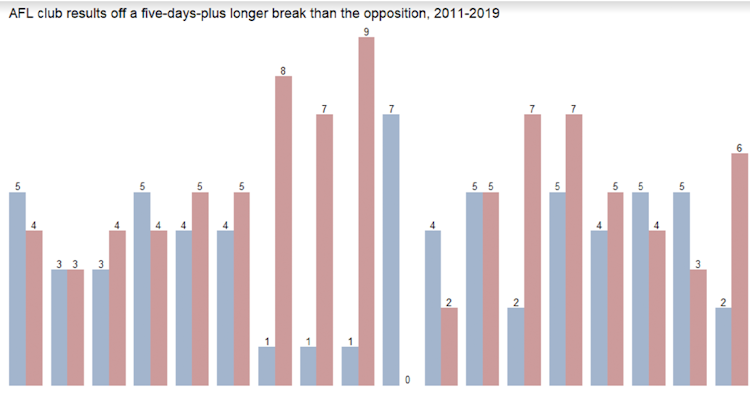Give It A Break: Do Shorter Turnarounds Really Disadvantage AFL Teams?
Last updated: Aug 5, 2020, 2:15AM | Published: Jul 19, 2020, 11:41PM
The AFL will in the near future make the unprecedented move of fixturing 33 games across 19 days of uninterrupted football, attempting to squeeze four rounds of the Coronavirus-affected 2020 season into as little time as possible.
No team will be threatening the record for the shortest gap between two games. 142 times in VFL history a club has played a match off as little as two-day break, most recently in 1938.
But could we see teams match, or even better the previous records of playing three games in eight days, or four games in 15? The latter might be a possibility, pending the release of the fixture.
RELATED: Size Matters: The Types Of Forwards Scoring For And Against Your Club
This got me thinking about breaks between games and to exactly what degree they have an impact on team performance.
There was a time when I scoffed at the suggestion that this might be a factor in football performance – but when I took up running (after a lifetime of otherwise studiously avoiding physical exercise of any kind) I learned quickly just how much benefit could be derived from a little extra recovery time.
But does an extra day’s break make an AFL team any more likely to taste victory? Luckily, we have more than a hundred years of data with which to answer a question like this.
To take a broad look at the question, I identified all VFL/AFL games where the two teams were coming off breaks of differing lengths.
This included only matches where both teams had already played at least one game that season (to avoid calculating a break across two different years) and only included data from before 2020, since this year has just been, let’s face it, a little weird.
All up that makes 4818 games, roughly three-quarters of them having occurred in the past three decades as the league has spread itself across an ever-increasing variety of timeslots.
And the results for those 4818 teams who played on the disadvantage of a smaller break: 2353 wins, 2412 losses, 53 draws. Or to put it another way, they won 49.3% of matches that weren’t draws.
At first glance that might suggest teams coming in off the shorter break were a little more likely to lose, albeit only a very little.
But think of it this way: if you tossed a coin 5000 times, would you expect to record exactly 2500 heads and 2500 tails? Unlikely.
How do we then determine the significance of a result like this?
In statistics, a concept called the binomial distribution is used to estimate probability in a situation like this. And to tell a long story short: these numbers are not statistically significant.
I considered another possibility: perhaps the short break doesn’t have an impact on teams when they get to play at home, but might have an impact when they need to travel interstate.
The numbers don’t support that theory either. Travelling teams get the win about 36.8% of the time, travelling teams who are also coming off a shorter break than their opponents run at 36.9%. You can tell for yourself that’s not a significant difference.
RELATED: Understanding how Clearances Shape the Results of AFL Games
So we can say with a degree of confidence that playing off a shorter break than your opponent doesn’t really seem to impact your chances of winning an AFL match. But what if we narrow our view to those matches where the difference between breaks is a bit larger?
I’m talking about matches where one team comes in off a bye and the other doesn’t, or to be exact, where the difference between breaks is at least five days.
 There isn’t a significant trend in matches like this over the whole breadth of VFL/AFL history, but in the last ten years, where they’ve become much more common than in the past, there is. When a team is coming off a bye and plays a team that isn’t, they only win 43% of the time.
There isn’t a significant trend in matches like this over the whole breadth of VFL/AFL history, but in the last ten years, where they’ve become much more common than in the past, there is. When a team is coming off a bye and plays a team that isn’t, they only win 43% of the time.
Geelong fans are famously familiar with this. The club has gone 1-8 in such matches since 2011. The incredibly talented, but wildly inconsistent GWS are the only club with a worse record at 1-9, while Gold Coast round out the podium at 1-7.
Not all teams are so badly affected. Hawthorn have gone 7-0 in these matches, putting them head and shoulders above the rest. Melbourne at 4-2, and West Coast at 5-3 are the next best.
So, do shorter breaks disadvantage AFL teams? The numbers both historical and modern suggest going into a match on a shorter break than your opponent doesn’t make you any less likely to win.
If anything, when it comes to matches with a significantly big difference between the respective teams’ breaks, the team that’s played more recently may well be at an advantage – though this is a trend that only holds true over the last decade or so.
Of course, this isn’t to say the short breaks to come – over the next few weeks, and possibly deeper in to 2020 – won’t be a significant challenge for clubs and players to face.
Fingers crossed that all goes smoothly, and injuries are avoided wherever possible.
NOTE: This article is provided by a guest writer. The stats and figures contained within were provided by the author; and do not constitute Stats Insider data. All opinions are that of the writer.
Did you enjoy this article? Join our free mailing list to get the best content delivered straight to your inbox, or join the conversation by leaving a comment below or on the Stats Insider Twitter or Facebook page.



